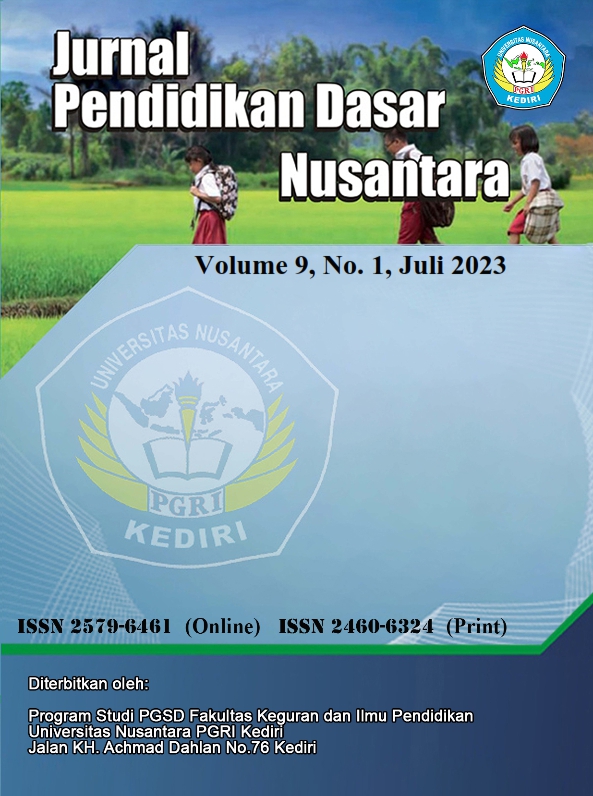Improving learning outcomes in economic activities materials through PBL models supported by interactive multimedia in sixth grade SDN Junrejo 2
DOI:
https://doi.org/10.29407/jpdn.v9i1.19978Keywords:
Learning Outcomes, PBL, Interactive MultimediaAbstract
This research aimed to : (1) describe the implementation of the Problem-Based Learning (PBL) model in improving the learning outcomes of Grade VI students (2) the improvement of students' learning outcomes with the application of Problem-Based Learning (PBL) supported by interactive multimedia can enhance the learning outcomes of Grade VI students. The data collection technique used descriptive quantitative by comparing student learning outcomes after and before the class action. With data collection techniques using tests, observations, and interviews. The results of the research before the class action treatment were 8 students in the first cycle of mastery the learning outcomes of students above the KKM increased by 14 children. Whereas in cycle II the completeness of student learning outcomes increased by a total of 18 out of a total of 20 students. This can be presented before the class action classically obtained 40% then in cycle II the percentage increased to 60%. In cycle II, the percentage of completeness of student learning outcomes increased by 85%.
Downloads
References
Akbar, Sa’dun. 2009. Penelitian Tindakan Kelas. Yogyakarta: Cipta Media Aksara
Akhmad, dkk (2023). Penerapan Model Pembelajaran Problem Based Learning Dalam Meningkatkan Hasil Belajar Matematika Siswa Sd, 10(2), 1-15 https://jurnalilmiahcitrabakti.ac.id/jil/index.php/jil/article/view/1462
Bekti Susanti, Alfera (2023). Upaya Peningkatan Hasil Belajar Daring Pada Tema Globalisasi Melalui Media Belajar Berbasis Game Edukasi Quizizz Siswa Kelas VI SD Negeri Kesongo 01 Kabupaten Semarang, 6 (1), 1-15-10
https://e-proceedings.iaipalangkaraya.ac.id/index.php/PPGAI/article/view/1274
Arikunto, Suharsimi. 2010. Penelitian Tindakan Kelas. Jakarta: PT. Bumi Aksara
Ariani, Niken., dan Haryanto, Dani. 2010. Pembelajaran Multimedia diSekolahPedoaman Pembelajaran Inspiratif, Kontstruktif, dan Prospesktif. Jakarta: PT. Prestasi Pustakarya
Dakhi, Agustin Sukses. 2020. Peningkatan Hasil Belajar Siswa. Jurnal Education and development Institut Pendidikan Tapanuli Selatan. 8 (02)-470
Darmawan, Dreni. 2014. Teknologi Pembelajaran. bandung: PT. Remaja Rosdakarya.
Depdiknas. (2003). UU No. 20 Tahun 2003 tentang Sistem Pendidikan Nasional.
Daryanto.2010. Media Visual untuk Pengajaran Teknik. Tarsito Bandung
Fauziah, R. 2015. Penerapan Model Pembelajaran Problem Based Learning untuk Meningkatkan Proses dan Hasil Belajar Operasi Hitung Siswa SD (Doctoral dissertation. Universitas Pendidikan Indonesia).
Hamalik, O. (2012). Proses Belajar Mengajar. Jakarta: PT. Bumi Aksara
Indari, Pratiwi Dyah, dkk. 2020. Upaya Meningkatkan Hasil Belajar Kognitif Ips Materi Kegiatan Ekonomi Melalui Penerapan Video Bandicam Pada Siswa Kelas Iv Sd Negeri Nolobangsan. Prosiding Pendidikan Profesi Guru Sekolah Dasar. http://eprints.uad.ac.id/21224/1/20.%20Pratiwi%20Dyah%20Indari-PGSD%20%28209-218%29.pdf
Kamarianto, K., Noviana, E., & Alpusari, M. 2018. Penerapan Model Pembelajaran Problem Based Learning untuk Meningkatkan Hasil Belajar IPS Siswa Kelas IV Sd Negri 001 Kecamatan Sinaboi. Jurnal Online Mahasiswa (JOM) Bidang Keguruan dan Ilmu Pendidikan, 5(1), 1-12.
Kurnia, U., Rifai, H., & Nurhayati, N. 2015. Efektivitas Penggunaan Gambar pada Brosur dalam Model Pembelajaran Problem Based Learning untuk Meningkatkan Hasil Belajar Fisika Kelas Xi Sman 5 Padang. Pillar Of Physics Education, 6 (2).
Latifah, U. (2017). Peningkatan Pemahaman Konsep IPS Melalui Penerapan Metode Active Learning Tipe Index Card Match Pada Siswa Kelas VA SD NgotoTahun Pelajaran 2016/2017 (Universitas Negeri Yogyakarta; Vol. 14).
Mirnawati, L., B. (2017). Pengaruh Model Pembelajaran Kooperatif Tipe Group Investigationterhadapkreativitas Mahasiswa Semester I Pgsd Um Surabaya pada Matakuliah Pengantar Manajemen Pendidikan. Jurnal Pendidikan 6 (1): 84-85.
Munadi, Yudhi. 2013. Media Pembelajaran. Jakarta Selatan: GP Press Group. Naseer, Muchamad., dan Harsemedi, Gede. 2013. Sistem Multimedia. Yogyakarta: Andi.
Shoimin, Aris. 2014. 68 Model Pembelajaran Inovatif dalam Kurikulum 2013. Depok: Ar-Ruz Media
Sudjana, Nana. 2011. Penilaian Hasil Proses Belajar Mengajar. Palangkaraya. PT. Remaja Rosda Karya.
Sundari, K., & Andriana, S. (2018). Upaya Meningkatkaan Pemahaman Konsep Siswa Melalui Model Artikulasi Pada Mata Pelajaran IPS di Kelas V SDIT An-Nadwah Bekasi. Pedagogik, VI(2), 109–116.
Tsabit, Amalia dan Maula. Analisis Pemahaman Konsep Ips Materi Kegiatan Ekonomi Menggunakan Video Pembelajaran IPS Sistem Daring Di Kelas Iv.3 SDN Pakujajar CBM. Jurnal Ilmiah Pendidikan Dasar V(01). https://www.journal.unpas.ac.id/index.php/pendas/article/view/2917
Widoyoko, E. P. (2009). Evaluasi program Pembelajaran, Panduan Praktis bagi Pendidik dan Calon Pendidik. Yogyakarta: Pustaka Pelajar.
Zahwa, Feriska Achikul dan Syafii Imam. Pemilihan Pengembangan Media Pembelajaran Berbasis Teknologi Informasi. Jurnal Penelitian Pendidikan dan Ekonomi 19 (01) https://journal.uniku.ac.id/index.php/Equilibrium/article/viewFile/3963/2876
Downloads
Published
Issue
Section
License
Authors who publish with this journal agree to the following terms:
- Copyright on any article is retained by the author(s).
- The author grants the journal, the right of first publication with the work simultaneously licensed under a Creative Commons Attribution License that allows others to share the work with an acknowledgment of the work’s authorship and initial publication in this journal.
- Authors are able to enter into separate, additional contractual arrangements for the non-exclusive distribution of the journal’s published version of the work (e.g., post it to an institutional repository or publish it in a book), with an acknowledgment of its initial publication in this journal.
- Authors are permitted and encouraged to post their work online (e.g., in institutional repositories or on their website) prior to and during the submission process, as it can lead to productive exchanges, as well as earlier and greater citation of published work.
- The article and any associated published material is distributed under the Creative Commons Attribution-ShareAlike 4.0 International License

































